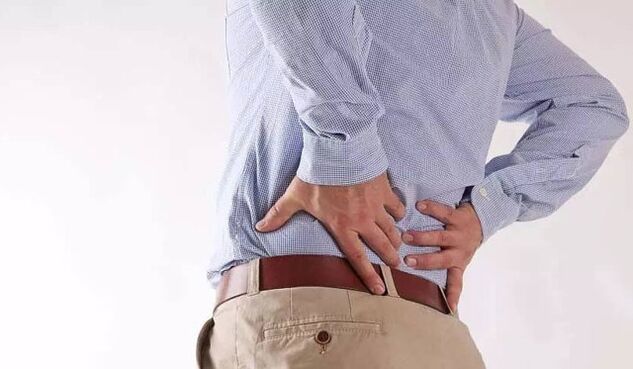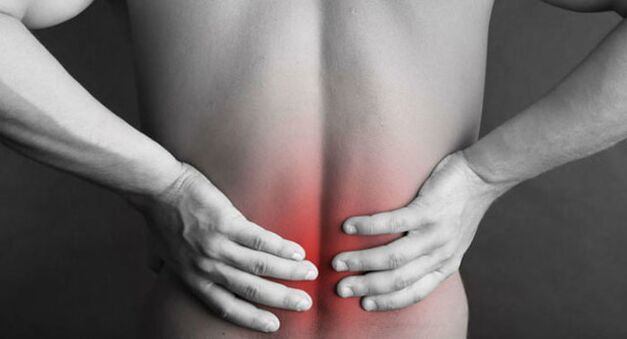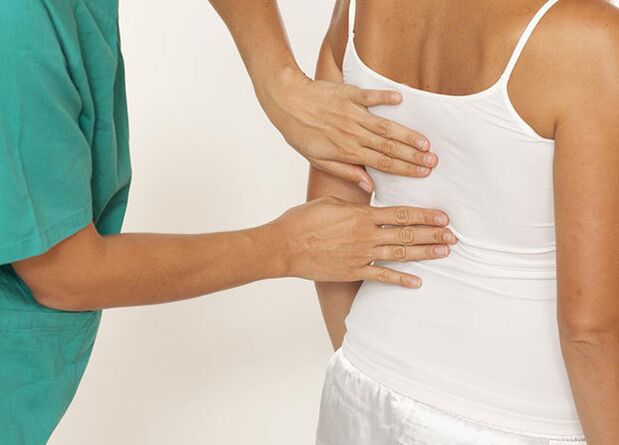About 80% of people over 55 years experience manifestations of various diseases of the back and should not neglect the faces of younger age categories. One of the most common diseases of the vertebral column column osteochondrosis of the lumbar spine is also found in patients from 25 to 45 years. Even young people between the ages of 16 and 25 are increasingly suffering from symptoms and causes of this extremely unpleasant illness. The question is logical whether it is possible to stop the tendency of the number of patients in general, and what kind of preventive purposes to do with every person in order not to be a victim of this pathology?

Symptoms
With inadequate attention for this disease and out of date diagnosis, your treatment is difficult if secondary diseases or complications occur. Osteochondrosis begins to progress as a natural continuation of pathology. His treatment is not always effective, and if this is incorrectly exacerbated or incorrectly prescribed therapeutic course, a risk of disability occurs. Another characteristic problem is the appearance of false hernia, which is accompanied by unbearable painful sensations. Every day there will be the chances that irrevocable hernia will get rid of.
The characteristic clinical symptoms help to recognize the disease in the early stages and to avoid these sad consequences:
- Sharp pain after night sleep;
- Pain with sharp spreads of the body or severe things;
- The body becomes inactive;
- Signs of scoliosis occur;
- The dream becomes restless;
- Depressive moods arise;
- Frequent urination is noted.
An independent evaluation of these symptoms cannot be correct, since most of them have a common resemblance to signs of other diseases in the spine or joints. Therefore, only a rheumatologist or orthoper has the competence to talk about the presence of an osteochondrosis of the lumbar region.
classification
Differential diagnosis for the correct determination of the disease, to distinguish identical pathologies and determine the course of treatment, the classification of the stages of this disease helps:
- Level 1 - At this point, the structure of the cartilage is only changed. But now pathological processes are influenced by roots of nerve endings. As a result, pain is given in the legs. At the same time, blood flow worsens and inflammation is born. Pain is acute or stupid and mainly appear after reinforced loads on the axis of the back.
- The 2nd stage begins with the destruction of the fibrous ring in the spine, while the cartilage is thinner and the vertebrae reduces the distance. Pain in the second stage are sharp and sharp, sometimes inappropriate. During this time, the mobility of the spine is intensified in its axis, nerves occur, pressure on the soft tissue of the muscle corset is formed;
- Stage 3 is characterized by strong compression of muscle fibers and nerve roots. Unbearable cramps and pain occur with a burning character. In the area of defeat, numbness feels. With intensive development of the disease, signs of paresis and paralysis occur;
- Stage 4 - growth period of already educated osteophytes (neoplasms with the bone structure). In this stage, changes in degenerative nature are activated, osteoarthritis in the spine and joints occur. The back becomes inactive and in the absence of the right treatment - completely motionless.
Diagnostic methods
Since even the ideal knowledge of the clinic and the classification of osteochondrosis of the lumbar spine does not give a complete idea of the pathological processes provoked by Him, a doctor who is engaged in the treatment of pathological processes in the spine, ailments of the musculoskeletal system or theOrthopedist has to be prescribed to Additional Diagnostic Examination:
- X -Ray in the frontal and lateral projection - it enables the distortion of the axis, the formation of East Fiten to identify anatomical anomalies of the vertebrae;
- Magnetic resonance domiting is the condition of the entire zone of the back damage, fragments of destroyed vertebrae, cartilage and places of inflammation;
- Computer tomography gives an idea of the state of soft tissue, bones of the vertebrae, the outer shell of the intervertebral disc, in principle, which is basically for its integrity. and blood circulation in the area of localization of the disease.

At the same time, the patient takes tests for a rheumatoid test, general blood indicators, the content of biochemical components. With the overall survey results, you can precisely determine the diagnosis and identify the development stage of the osteochondrosis of the lumbar region.
Symptoms and treatment of osteochondrosis of the lumbar spine
Under the frequent causes of pain in the back of the back, osteochondrosis of the lumbar spine, symptoms, the treatment of which has their characteristic features. The disease is the initial stage of osteochondrosis in connection with the destructive process of the cartilage ring, the intervertebral discs, a change in reducing, forming swelling and nerve roots. Young and older people can face the disease, regardless of gender, social status and religion. A long lack of manifestation of the symptoms of the disease leads to the loss of the precious time and to the transition from a stage of the disease to more severe forms of its development. The main difference feature of osteochondrosis is the border zone of dystrophic changes in the tissues of the vertebrae that do not go beyond the articular cartilage.
Causes of the early stages of osteochondrosis
A number of external and internal factors determine the development of the pathological state of the lumbar region of the axial skeleton. A lumbar osteochondrosis appears due to certain risk factors. This includes:
- Aging of the body after 50 years;
- Improper posture and anomaly of the anatomical structure of the axial skeleton, which determines the unequal load of the vertebrae;
- Weights with a weak muscle frame;
- Settlement of the patient's body as a whole and in the lower back separated;
- Functional disorder of metabolic processes, work of endocrine organs, cardiovascular system;
- Uneven loads on the spine during the fulfillment of production tasks, household work, professional and amateur sports;
- Pathologies of the musculoskeletal system of innate or acquired nature;
- Hypodynamics, high frequency of stressful situations;
- Excess body weight of the patient;
- Lack of vitamins, minerals and trace elements in the body of a sick person who are responsible for the health of the spine;
- Acquisition of shoes with high bargains and unpleasant platforms;
- The use of high pillows and soft mattresses during peace and sleep.
The frequency of the diagnosis of osteochondrosis of the lumbar skeleton is determined by the number of risk factors for its development, which are present in the patient's life.
Diagnosis of the disease
The determination of the degenerative-dystrophic lesion of one of the five vertebrae of the lumbar area of the axial skeleton ensures diagnostic measures. You will be prescribed by a doctor. When consulting with a specialist who knows how to treat lumbar osteochondrosis, an anamnesis of the disease is collected, the time and characteristics of the manifestation of signs, the intensity and the location of the localization of painful sensations are clarified. The condition of the muscle fibers in the damage zone is determined by visual examination. The use of the palpation method offers a doctor the opportunity to see a picture of the symmetry of the vertebrae and the distance between them. The final diagnosis is determined after receipt of the results of additional studies. This includes:

- X -Ray, carried out in two projections and offers the possibility to see the position of the vertebrae, the height of the disks, the seal of the border bone plates and growth;
- Magnetic resonance imaging, a special research method, to determine the condition of the vascular system and fibrous rings in the degenerative dystrophic lesion zone.
The goals and methods of treating pathology
The results for the treatment scheme for the osteochondrosis of the lumbar loin skeleton, which pursues certain goals, are the basis for the treatment scheme. This includes:
- a decrease in pain intensity caused by degenerative-dystrophic lesions of one or more vertebrae of the lumbar skeleton;
- Normalization of metabolic processes in cartilage, its restoration and exclusion of the risk of their further destruction;
- Reduction of the load on the nerve fibers;
- Increased blood flow in the tissues of the spine using massages, physiotherapeutic methods;
- Strengthening the muscle frame of the axial skeleton through regular exercises recommended by the instructor.
The therapy of chondrosis of the lumbar spine, the symptoms and treatment of which have their own characteristics, consists of taking and using pharmaceuticals, recipes of traditional medicine, methods of unconventional treatment, including hirudotherapy. An effective addition to solving the problem of pathology is physiotherapy, water, massage methods, gymnastics and sport, including special exercises. The drug therapy includes the use of anti -inflammatory non -steroidal medication, muscle relaxants, chondroprotectors, vitamin complexes with trace elements and minerals.
In the event of very severe pain, novocaine or lidocaine blocks are prescribed, which are carried out by introducing injections into the affected places of the vertebrae. For local use, ointments, gels, creams, plaster with heating, anti -inflammatory effects are prescribed. The physiotherapeutic treatment includes the passage of healing courses in electrophoresis, diaynamic currents, exposure to ultravioletus, manual, shock wave and reflex zone massage. In the absence of a positive dynamic, the appearance of hernial promotion is prescribed a surgical operation. In order to avoid the development of complications with the occurrence of the first symptoms, the treatment must begin immediately.
Lumbale osteochondrosis
The osteochondrosis lumbar is one of the most common forms of the underlying disease, actually osteochondrosis. Lumbal osteochondrosis, the symptoms of which are determined by men and women equally, which manifest themselves in the form of pain that is concentrated in the sacrum area, is reflected in their symptoms and on the lower extremities, which are often determined by patients as "clamping of the lumbar nut".
Leadership for the osteochondrosis lumbar
Protesis in this area of interest for us develops most frequently, and it is projections that cause the occurrence of pain in the lower back. The lumbar region itself is most of the development of certain functional problems in view of its position and characteristics. This means that if one takes into account this statement on the one hand, it can be differentiated that our focus is on the lumbar department, and precisely on the fact that an essential part of the burden is the discussion. On the other hand, it can be noted that a significant amplitude of movements in turn falls on this lumbar region. In view of this, the greatest tendency towards damage (as well as suggestions that are interested in us) lies on the panes concentrated in the lumbar spine. In addition, we must not forget that changes in discs occur in this and of course in other areas, including against the background of the age -related degenerative process.
Remember our readers what the projections themselves are. The connection of the slices in the spine is provided by the wheels based on cartilage based on cartilage. The main components of the intervertebral disc are a bracket and a fiber ring, through which the fixation is provided within the framework of the spine. The effects of certain factors and conditions provoke the possibility of breaking this ring against the background, the core lead of which again occurs. Hernie develops as a result of this process. As far as the lead is concerned, it already develops as a result of a similar course of the process, but without the simultaneous break of the ring - in this case it is simply thinner and not a break, since the core stands out directly through the ring. In fact, this lead is defined as a lead.
As far as the symptoms of a preliminary form are concerned, it manifests itself as follows:
- A feeling of stiffness in the lower back;
- Pain in the lumbar region;
- Lower pain of chronic nature;
- Lumbosacral radiculite;
- Daubiness, pain, tingling of the fingers on the legs in their feet;
- Impaired urination functions (in rare cases of the tested pathology).

Most of the time, conservative treatment is applied to the lumbar's lead. In the meantime, severe symptoms that are resistant to treatment are often accompanied in the development of the advantage. In this case, you can no longer do without surgical intervention.
Treatment
Most of the time, the treatment of osteochondrosis is multi -component and rather complicated in its implementation. Most of the time, all therapy measurements are reduced to the following points:
- Drug treatment;
- if necessary - surgical treatment;
- Diet;
- Medical physical education.
A deterioration in the disease initially requires compliance with the bed rest for patients. The main recommendation for this part is a hard/hard sleeping place. Attacks are extremely expressed in the manifestations and offer the need for a minimal motor load and in early contact with the responsible specialist.
























